The crayon markings of Herb’s friend proved difficult to decipher, but we believe the following to be an accurate transcription of the results. In each case, we present the design and covering letter, followed by Mr. Hobnob’s expert opinion and score.
So, in no particular order:
Candidate 1
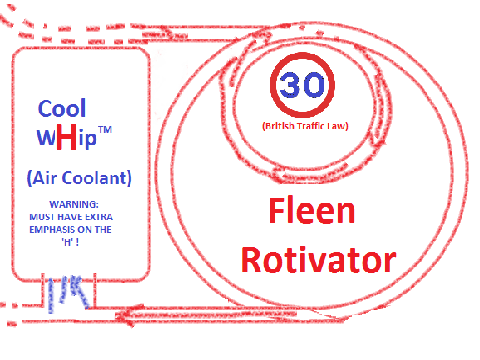
Fleen Rotivator candidate design 1
Hi Helpdesk, Here is my design: Basically you put some mashy-balls (or bally-mash) into the Hutler Distributor. This then separates the two into two circuits and then accelerated. At first they are only sped up to 30mph due to British Traffic Laws, but as soon as someone turns a blind eye, they are accelerated to the speed of light and smashed together. As a result, a lot of heat is produced. Even though you have to waste a bit of mash doing this, you can create brilliant heat, which can then be fed back in to dry out the mash balls. Awesome? Nick.
Addendum:
Update of design! 50% more efficient! Word of caution - if you don't put emphasis on the H... well... let's not go there!
Hobnob says…
Adherence to spec:
- Correct dimensions
- Correct input/output locations (revised version only)
- Correct colouring
- Marker-compatible
- BoldenanceXS(tm) rendering may be required for full BoardCam visibility (small text, small bore synchrotron)
Pros:
- Compact design (very space-efficient)
- Uses cutting-edge technology which should ensure tight tolerances on the final sphericularity
- Opportunity to set up a sideline business as a spallation EBM source
- Rapid cooling with Cool wHip should give a nice crunchy outer shell with just the right amount of resilience
Cons:
- No mention of hidden costs (liquid helium, monthly quadrupole magnet realignment, spider shoes)
- Safety could be improved by adding a Mark III HHHHEMphasiser unit
- Some wastage of mash (though still significantly less than the Blewdly-Streimpher Mark 1)
Overall rating: 28/40
Candidate 2
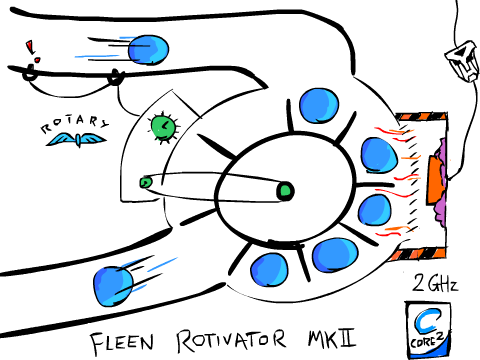
Fleen Rotivator candidate design 2
Dear Helpdesk, As per your request please find enclosed the design for the Fleen Rotivator MkII. It functions in similar manner to the MkI, though we've added a new timing mechanism (courtesy of Rotary) to better control the speed of the wheel. We've also raised the clock speed of the Core 2 Duo to 2.0GHz and added even more thermal paste, to ensure optimum heat levels. You may recall Apple's MacBook Air cooked itself quite nicely at just 1.6GHz, so we're confident our implementation should thoroughly dry out the candy. Finally, we've gone with a business-grade Autobot™ transformer. Please take care when connecting this to the Electro Chemical Bath. If you have any queries regarding installation or future maintenance, please don't hesitate to get in touch. Kind regards, James Leedham.
Hobnob says…
Adherence to spec:
- Correct dimensions
- Correct input/output locations (revised version only)
- Incorrect colouring (uses black, though most black lines could be replaced with other colours)
- Mostly marker-compatible (shading would not work)
- Would be legible on BoardCam (corporate logos not so much, but this isn’t a popup ad so meh)
Pros:
- Tried-and-tested fleen rotivation mechanism
- Business-class precision components ensure quality
- Readily available heating hardware (can be recycled from old lab machines)
- Bird-actuated emergency shutoff cord meets ISO9002 safety requirements
- Grunkle
Cons:
- Yearly downtime required for winding
Overall rating: cos(4.5-2)
Candidate 3
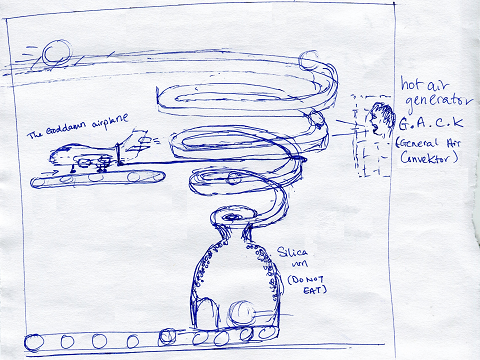
Fleen Rotivator candidate design 3
Dear Mr. Hoove, Please find attached the new Fleen Rotivator design. Please try not to 'misplace' this one as we are running low on paper and ink to draw them...as a consequence this design is monotone. Please feel free to use components in different colours if you wish. Yours Sincerely, Clare Lam and John Isger (Fleen Inc. Head Designers)
Hobnob says…
Adherence to spec:
- Correct dimensions
- Correct input/output locations
- Correct colouring (if a bit monochromatic)
- Marker-compatible
- Would be legible on BoardCam (some small text would have to be enlarged but space is available for this)
Pros:
- Web 0.1 compatible
- Marginally esoteric file format
- Implements a low-running-cost Assymetric Fleen Heating System, but without the usual issue of monosilane buildup thanks to the separate silica stage
- Minimal lempobembance
Cons:
- Requires an “airplane”, which would need to be rented or purchased from America, increasing costs
- Vulnerable to foreign volcano activity
Overall rating: (19 × √3) / 50
Candidate 4
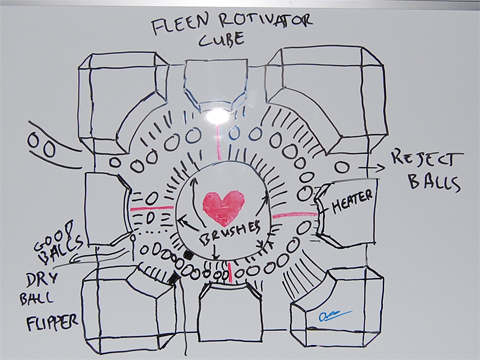
Fleen Rotivator candidate design 4
Hey, Attached is my Fleen Rotivator. A link the the bigger (clearer?) one, with added naming label: [link removed] (which you should be able to see) Note: My blue ran out, so I used black - all black replaced with blue is what it was meant to be. The blue smudge in the bottom right is my signature from before the image was modified. Oli
Hobnob says…
Adherence to spec:
- Correct dimensions
- Incorrect input/output locations (additional output detected; STDERR was not in the spec!)
- Correct colouring (use of black as a substitute for blue justified in documentation; blue to be used in live implementation)
- Marker-compatible
- Would be legible on BoardCam
Pros:
- Stable structure
- Close packing of balls for efficiency
- Cake-compliant as per ISO2323.55
Cons:
- Close packing multi-cycle system is likely susceptible to jamming (jam is not in the spec)
- Many wasted space. MANY.
- May incur lawsuits
Overall rating: 1 / (tan 0.94)2
Candidate 5
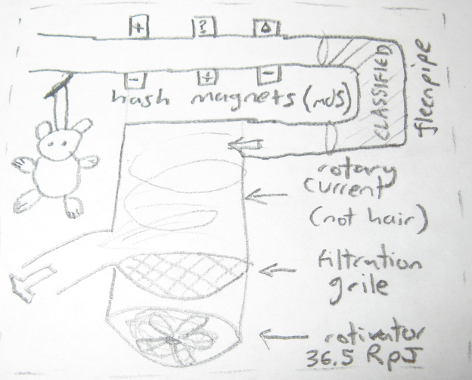
Fleen Rotivator candidate design 5
My proposal for the Fleen Rotivator design follows, which is named 'Legerity'. The balls of candy when entering Legerity may contain impurities of form (contrasted with impurities of essence, something we do not need to deal with), and they are passed through six 'hash magnets', initialized to use the well-documented MD5 algorithm. [1] This ensures that no possible flaw can disturb the fleenpipe (United States Patent D612,020; details classified). Once this process is completed, the now throughly dry balls of candy, then are rolled into the rotary current of a cylindrical tube, provided by the rotivator, working at 36.5 RpJ (SI Unit kg.s-2.A-1). The gentile rotation this provides, cools the candy balls, allowing them to reduce in size slightly and 'set'. Once they land on the 'filtration grile', they are then rolled out into the rest of the machine. There is a mascot hanging on one of the pipes, because stuffed animals make everything better. [1] Despite security concerns over the MD5 algorithm, use of the SHA256 algorithm would require over forty times more pipe length, and would decrease the relative speed of the design. Advantages * The Legerity design provides minimum jitter for the delicate balls of candy, ensuring that their semi-spherical existence is not in any way jeopardized. * The compartmental design allows for more maleficent growth if the circumstances change. * The secrecy of the fleens is never troubled. * Never trouble them. Possible Disadvantages * In non-earthlike environments, the gaseous composition of the cylindrical tube would have to be tightly controlled, to ensure proper casting. * Mice have been found living in some of the nooks of the prototype. Whether this is a flaw that would be shared by the actual design is unclear. * There aren't nearly enough explosions. Once every minute (when the fleentupe ******s with the surrounding air, isn't often enough in our engineer's onion's opinions. Estimated Cost * Three shiny metal disks, a piece of magical cotton, and a song.
Hobnob says…
Adherence to spec:
- Incorrect width (though within spec)
- Incorrect height (outside spec)
- Incorrect input/output locations (additional output detected; NO STDERR STREAM SPECIFIED!)
- Incorrect colouring (Grey Is Not A Valid Shade)
- Marker-compatible
- Would probably be mostly legible on BoardCam
Pros:
- Well documentationalised with many salient prunkts befismalated and proper SI units encormpulcaned
- Teddy bear compliant
Cons:
- Not Stallman-compatible (contains a closed-source section which does most of the actual work)
- Documented security concerns over the use of MD5 hashing; this would require a thorough investigation
- Extortionately priced
Overall rating: 0.27 / cos(50)
Summary, Results and Maths
There was some initial ambiguity as to who the final winner would be. The scores given by Mr. Hobnob use trigonometric functions but give no indication of anglular measurement convention. Herb wasn’t much help, as he claims angles are best measured in terms of “will it fall over if I give it a shove”.
We have determined that all scores fall within the range 0 – 1 if angles are measured in radians so we have based our ruling on that. Using alternative measurement schemes results in extreme outliers. If Mr. Lea wishes to argue in favour of degrees and claim his over-3000 points (cash value 27p) he should do so in person at the next convenient opportunity.
Normalized results
First place: James Leedham with 0.999
Second place: Nick Hatter with 0.700
Third place: Clare Lam & John Isger with 0.658
Fourth place: Oliver Lea with 0.533
Fifth place: Jack Edge with 0.420
Many thanks to all for participating. A crude reproduction of the winning design may be seen on Boardcam now!
Also, would Mr. Leedham please make his way to Helpdesk to collect his prize.
leave a reply